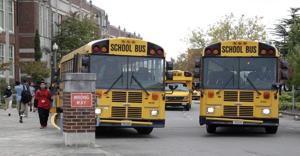Washington schools fall back on federal dollars amid falling attendance rates

(The Center Square) — Fewer students may mean less money for school districts in Washington, where lawmakers are reworking the state’s balance sheets to keep teachers on payroll.
According to state law, Washington school funding is based on enrollment which has districts pocketing more money the more students they have. That formula has put schools at risk for big dips in funding next year as the challenges of the COVID-19 pandemic chases more students out of real and virtual classrooms.
In December, the state Office of Financial Management reported enrollment in grades K-12 had fallen by about 4% statewide from some 1.1 million students to little more than 926,000 after decades of steady growth.
Since late last year, Gov. Jay Inslee granted Washington schools the leeway to resume in-person instruction despite opposition from teachers unions and mixed consensus from parents.
According to state education data, nearly a quarter of Washington’s K-12 students were learning in-person on any given day. A third of them were in grades K-5 compared to 27% of middle and high schoolers.
School districts around the state are going to be cash strapped for years to come, as theories abound about why enrollment is falling and whether it’s private schools attracting families disillusioned with remote learning or not.
For the Olympia School District, attendance is down by about 4% over the past year and $6 million in enrollment-driven revenue, Assistant Superintendent Jennifer Priddy testified to the House Appropriations Committee on Tuesday.
The story is worse for neighboring North Thurston Public Schools whose shortfall is about $10 million. To date, it’s lost an average of 40 students per month, according to Assistant Superintendent Marty Saban.
For the Camas School District, the shortfall is $5 million, Superintendent Jeff Snell testified to state lawmakers on Tuesday.
Under House Bill 1476, the state would reach deep into its pockets to cover the difference with federal dollars from December’s $824 million relief package.
The bill bases school funding formulas for the 2021, 2022, and 2023 school years on higher pre-pandemic enrollment rates from the 2019 school year in an effort to stabilize school budgets and above all the state’s teacher pool.
“I’m worried at a time when we need more resources to help kids that are struggling, resources will go down,” Davenport School District Superintendent Jim Kowalkowski said. “It will take a few years to bounce back from the current funding models. We’re not saying this bill will provide a bridge, a lifeboat, a safe harbor.”
The bill, which takes effect immediately upon passage, had 17 Democratic sponsors on Tuesday and garnered support from teachers unions and school district bosses.
Lorrell Noahr, a lobbyist representing the Washington Education Association, told lawmakers on Tuesday the union still had concerns that federal money could be better spent with an eye on low-income and districts of color.
“Congress recognized the need for additional supports to these communities by allocating additional targeted federal funds to schools before the pandemic that were further behind when it came to digital devices broadband access, and stepped up to provide a greater share of essential services such as meals, childcare and family support,” Noahr said. “But in this bill, these federal code relief dollars are subtracted from the state allocation determinations, spreading the combined support equally, but not equitably.”
School choice proponents have drawn a hard line against what they describe as the state’s failed remote learning model even Washington Superintendent of Public Instruction Chris Reykdal has denounced in no uncertain terms.
Two bills in the Washington Legislature, House Bill 1215 and Senate Bill 520, would hand families the money to pay for private or homeschooling.
“These students are not getting the education they were supposed to get,” said Liv Finne, education director at the Washington Policy Center. “Yet this bill would pay the public schools for not educating students who have withdrawn in essence, this bill would fund empty seats in our schools.”
Washington lawmakers are getting creative in their approaches to coming school years, which include cutting out traditional summer vacations and offering make-up years. The merit of those ideas may depend on how long the pandemic persists and at what cost to state coffers.
The state does not anticipate vaccinating teachers against COVID-19 until spring at the earliest. Seniors ages 65 and older were among the most recent groups to become eligible for priority shots last month.
HB 1476 awaits executive action by the state House Appropriations Committee.
Disclaimer: This content is distributed by The Center Square



